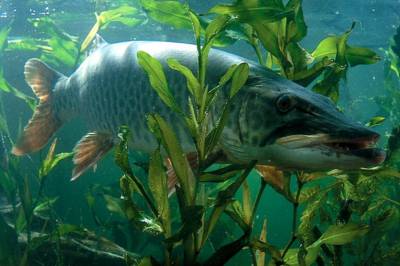


|
Main » Entries archive
Microsmatic fish are represented by species in which the well developed
visual system provides most of the behavioural responses in comparison with the
less developed chemosensory system (Devitsina & Malyukina, 1977). Visually
guided diurnal or twilight predators, like Northern pike, Esox lucius, and other Esocidae, on the one hand, and visually
guided planktoneaters, like Black Sea black-striped pipefish,
Syngnathus nigrolineatus, and
other Syngnathidae, on the second hand, form this group of fish (e.g.,
Doroshenko, 2008). In general, the chemosensory system of microsmatic fish
provides first of all their reproductive behaviour, spatial migration,
partially anti-predator behaviour and is weak or indifferent in providing
feeding responses.
Data for microsmatic fish are given by many authors (Hara, 1975; Devitsina, 1977; Devitsina & Malyukina, 1977; Doroshenko, 1981, 2008).
Pike & Musky
According to data received by Devitsyna & Malyukina (1977) in the electrophysiological experiments, the olfactory system of pike, E. lucius, responds
only to conspecific sexual pheromones (gonad extracts), but does not respond to conspecific odors, pure water and feeding substances like fish blood or tissue extracts. In the behavioural
experiments with pike, Nilsson & Brönmark (1999) have found that the
chemical cues from the foraging conspecifics render only minor effects upon
the foraging individuals. In the behavioural
experiments with pike, Nilsson & Brönmark (1999) have found that the
chemical cues from the foraging conspecifics render only minor effects upon
the foraging individuals.
In feeding behaviour, musky, E. masquinongy, use mainly vision and lateral sensory systems (New et al., 2001).
Pike larvae decrease the frequency of their attacks
on zooplankters and show other anti-predator responses to chemical cues of Eurasian
perch, Perca fluviatilis (Lehtiniemi,
2005; Lehtiniemi et al., 2005). Chemical cues of perch (water
from under adult predators, 15
cm length, fed on pike larvae until experiments) affect alone,
but chemical and visual cues offered together are more effective. Furthermore, it is shown that pike are attracted by alarm
pheromone of fathead minnow, Pimephales
promelas (Mathis et al., 1995; Chivers et al., 1996; indirect data by Wisenden
& Thiel, 2001). In addition, pike demonstrate distinct foraging responses
to artificial hypoxanthin-3(N)-oxide (Mathis et al., 1995) identified as an
active component of ostariophysan fish alarm pheromones.
...
Read more »
|
|
CALENDAR |
|---|
| « April 2024 » | | Su | Mo | Tu | We | Th | Fr | Sa | | | 1 | 2 | 3 | 4 | 5 | 6 | | 7 | 8 | 9 | 10 | 11 | 12 | 13 | | 14 | 15 | 16 | 17 | 18 | 19 | 20 | | 21 | 22 | 23 | 24 | 25 | 26 | 27 | | 28 | 29 | 30 |
|

|




